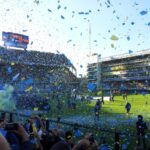


Statues featuring horses are a common hallmark of Buenos Aires. But what is the story behind these magnificent equestrian monuments?
Any visitor to Buenos Aires arrives with a number of questions. Where am I? Where am I going? Which subte line should I take? How much is the peso worth today? Was that really Spanish he was speaking? What am I drinking right now? How late is it (and does it really matter)?
There is one question, however, that always comes up but constantly is left unanswered: Who’s that guy on the horse?
Buenos Aires has at least nine different equestrian statues scattered throughout the city. One can barely walk outside to grab an empanada without bumping into some heroic general gallantly mounting his mighty steed (Whoa there!). These monuments are just about everywhere you look, but very rarely do people take the time to look up who the person is commemorating, and what they did to merit such an honor. Fear not, because like all those guys with their horses, we got your back. Here are some brief histories of the subjects of some of the better equestrian statues in the city.
To start, the courageous icon in the middle of Retiro’s Plaza San Martin is, you may have already guessed it, General José de San Martin. Born in Argentina before moving to Spain as a young child, San Martin returned to his mother country at age of 34 and became one of the most important and legendary figures in the history of Argentina. He is known as one of the great liberators of South America, credited with freeing Argentina, Chile and Peru. His “Army of the Andes” earned legendary victories against the imperial Spanish forces, and was knows as an intelligent and ruthless fighter. Think George Washington, minus the wig.
Not everybody agreed with his tactics, and upon returning to Argentina he was forced into exile in Europe. History has changed this perception, and in 1878, on the hundredth anniversary of his birth, the plaza was dedicated to him with a lavish monument to his accomplishments. The statue is actually a copy The Liberators, which today stands in Washington D.C., commemorating Western leaders who fought against colonial rule. Another interesting fact: nearby Calle San Martin is not named after this guy, but Saint Martin of Tours, the Catholic bishop. The General’s street is Avenida Libertador, so don’t feel too bad for him.
A quick stroll down to Plaza de Mayo gets you to our second contestant on “Who’s that guy on the horse?” Sitting in the shadow of the Casa Rosada is the Argentine jack-of-all-trades, Manuel Belgrano. Born in Buenos Aires, Belgrano was a politician, military leader, economist, journalist and lawyer. He was a leader of the Argentine Declaration of Independence on July 9, 1816 and is credited with creating the national flag, though his version didn’t have that sun-face in the middle. He also founded the Telegráfo Mercantil, the first newspaper in the country. If San Martin is the Argentine George Washington, then this guy is like Benjamin Franklin.
Though he died relatively poor and alone, he has received a plethora of posthumous commemoration. Aside from the statue in Plaza de Mayo, Belgrano has a horseless one in the barrio of Belgrano, in the center of (what else?) Plaza Belgrano. He is also commemorated in Rosario and Villa General Belgrano, along with Sucre, Bolivia and Genoa, Italy internationally.
From the Plaza de Mayo, you can see another gentleman on horseback, on the corner of Roca and Peru. That’s Julio Argentino Roca, a famous general and politician during the second half of the nineteenth century. Born in Tucumán, he joined the army before his fifteenth birthday and had worked his way up to Minister of War by the age of 34. He later became the ninth and fourteenth president of Argentina, serving a total of 12 years. He is credited with being a key figure in the federalization of Argentina, uniting the provinces and naming Buenos Aires the capitol. All that gives him the right to have his very tall statue oddly placed in the middle of the street, and if you don’t like it you can take it up with the two angry looking figures sitting beneath him, representing motherhood and work, respectively.
Moving over to Recoleta, we find Bartolomé Mitre, looking off into the distance from his horse in the plaza bearing his last name. Mitre was a revolutionary who was forced into exile by Juan Manuel de Rosas. He would later return to the country and serve as president of Argentina during the 1860s. He founded the newspaper La Nación in 1870, and was an accomplished writer of history, poetry and fiction. Oh, and his face is on the two peso bill.
Also in Recoleta, right next to the highly visited Plaza Francia, is Carlos Maria de Alvear. Alvear fought for the Spanish Army during the Napoleonic Wars, but on the side of revolutionaries during the Argentine War of Independence. He had a long political fight with Rosas and attempted to unite Argentina, Bolivia, Paraguay, Uruguay and Chile into one large republic, asking Simón Bolivar to be its first president. He was later named Argentina’s first ambassador to the United States, a move by Rosas to get Alvear out of his hair.
The last horseman on our tour is Giuseppe Garibaldi, who has set up shop high above Palermo’s Plaza Italia. Garibaldi was an Italian war hero, known for his ambitious military expeditions in both Europe and South America. He fought against Rosas in the Uruguayan Civil War. He was popularly known as a man of the common people and had a conflicted relationship with the Vatican. Late in his life he founded the League of Democracy, and, despite severe arthritis forcing him to stay in bed, married the mother of his three children at the age of 73.
(US) 910 795 2992
(AR) +54 9 11 —- —-
©Copyright 2025 Landingpadba, LLC